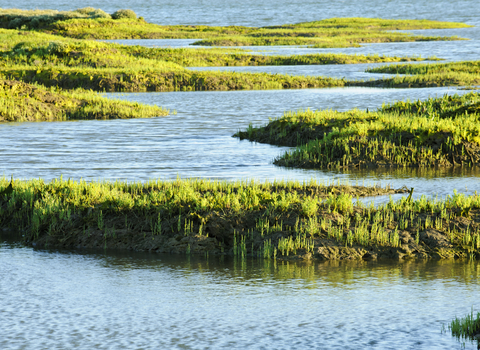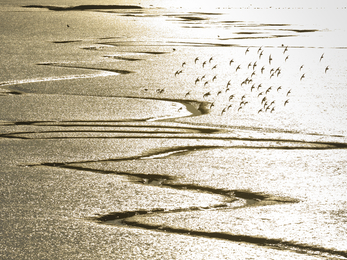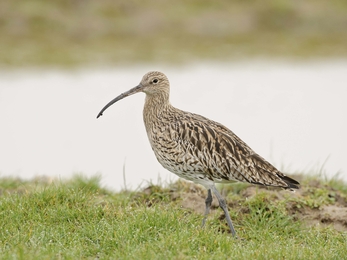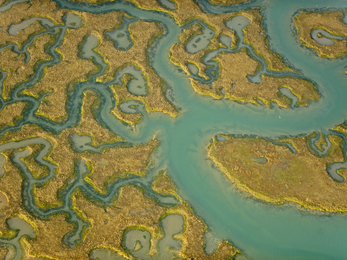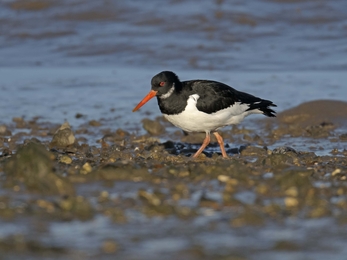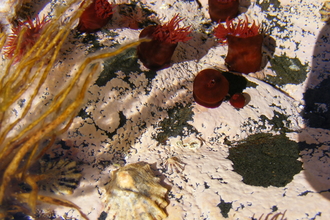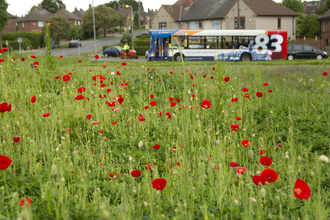Saltmarshes and estuaries
Estuaries: where rising and falling tides and the meeting of freshwater and salty sea create unique and dynamic habitats. Among these habitats are saltmarshes, forming in semi-sheltered areas, and supporting large populations of well-adapted species. Often important nursery areas for fish species as well as providing breeding and feeding sites for wintering waders and waterfowl, sadly, these vital refuges are now relatively rare in the UK, and The Wildlife Trusts are working hard to protect these unique ecosystems.
While the sight of so many birds in one place is simply breathtaking, the sound is something else – whether it is the clamour of geese, duck spooked by marsh harrier and peregrine or the haunting call of the curlew
Find a saltmarsh or estuary near you
Do a little research in advance and find out some of the best places to explore salt marsh and estuaries.
North
Cumbria Wildlife Trust
South Walney - Each spring, large numbers of lesser black backed and herring gulls return to South Walney to begin to set up nest territories. Also on the reserve are breeding eider duck, greater black backed gull, shelduck, oystercatcher, mallard, moorhen and coot. Many of the 250 bird species recorded, however, are passing migrants on their way to or from breeding grounds. These include common species such as wheatear, redstart, willow warbler and gold crest, as well as more unusual species, which may have been blown off their normal migration route.
In winter you can see large numbers of waders and wildfowl feeding and roosting around the nature reserve, both on the gravel pools and the intertidal areas.
Lancashire Wildlife Trust
The Ribble Estuary is the most important site in the UK for wintering wildfowl. It supports more than 250,000 ducks, geese, swans and waders, and is internationally important for 16 species of wintering birds. Many are attracted by the smelt and eel that make the most of muddy areas.
Arrivals begin from September: wigeon from eastern Russia; whooper swans and pink-footed geese from Iceland; and Bewick's swans from Siberia. Black-tailed godwit have bred on Newton Marsh, on The Fylde, since 1988.
The Ribble Estuary National Nature Reserve occupies over half of the Ribble estuary and is managed by Natural England. Lancashire Wildlife Trust has been involved with management of saltmarshes at Lytham where great white egret are seen regularly in spring.
Barnaby's Sands and Burrows Marshes - Lune & Wyre is an area made up of two estuaries that result in saltmarsh where river meets sea. The habitat provides a nursery for fish to mature and improve their chances of reaching breeding age. Eel and smelt are present, which attracts a large variety of birds.
The estuary includes Lancashire Wildlife Trust's Barnaby's Sands and Burrows Marshes - the last extensive areas of ungrazed saltmarsh on this coast. See if you can spot the rare rock-sea lavender at Barnaby's Sand.
Yorkshire Wildlife Trust
Spurn National Nature Reserve - Renowned by birdwatchers for its autumn migration spectacle, Spurn National Nature Reserve can be a wonderfully wild place over the winter months. The peninsula is cut off from the mainland at high tide so it is important to check the tide time carefully if you are planning to walk or cycle the 3.5 miles to the point.
On the estuary site of Spurn you will see knot feeding on the Humber mudflats along with other waders and on the seaward side. Look out too for harbour porpoise and grey seal as they take refuge close to the coast.
Kilnsea Wetlands Nature Reserve is a relatively new reserve, crafted from land formerly used for farming and opened to the public in 2012. The reserve was created to compensate for habitat being lost at the adjacent Brecon Lagoons Nature Reserve as a result of the coastal processes affecting the Holderness, and is a stone's throw from Spurn National Nature Reserve.
Providing a refuge for migrating and wintering waders the best time to visit is just before hide tide on a winters' day; the waders will arrive overhead from the Humber mudflats and drop down on to the reserve to roost.
Welwick Saltmarsh, a Site of Special Scientific Interest (SSSI), is the most extensive area of saltmarsh on the north bank of the River Humber, East Yorkshire; its creeks penetrate over half of the marsh allowing water to flow in and out with the tides.
Winter is a superb time to watch wintering raptors and owls, such as short-eared owl, merlin and marsh harrier to name but a few. Hundreds of large, curved-billed curlew feed on the edge of the saltmarsh whilst grey plover, knot and dunlin feed on the host of creatures living on the mudflats.
South
Devon Wildlife Trust
South Efford Marsh - A fascinating process of change is occurring at South Efford Marsh, on the Avon estuary in south Devon. A tidal floodgate has been installed at the southern end of the reserve, inundating part of the site each high tide. The land here had been saltmarsh for centuries until a stone and earth bank was constructed in the 18th century.
Now, the returning saltwater is beginning a process of saltmarsh re-creation with sea-loving plants like marsh samphire, sea purslane, sea aster and common cordgrass flourishing once more. Local birdwatchers report that the higher water levels have resulted in an increased number of birds on the reserve. Why not visit and see what you can spot?
Dawlish Inner Warren is a long spit of sand which curves like a huge question mark across the mouth of the river Exe. The curving sand dunes covered in marram grass form a small bay, which is one of the last places on the Exe estuary to be covered by each incoming tide. Thousands of wading birds gather here to feed on the invertebrates in the mud, moving gradually closer to the bird hide before the rising waters drive them off.
Hampshire & Isle of Wight Wildlife Trust
Farlington Marshes is a coastal grazing marsh and lagoon with both freshwater and brackish pools and a broad stream, which provides feeding and roosting sites for waders and waterfowl. Although not far from Portsmouth, you can escape the hustle and bustle of urban life walking along the sea wall footpath, enjoying stunning views of the reserve and across Langstone Harbour.
In the winter it's well worth wrapping up to watch thousands of dark-bellied brent geese in the marshes at high tide. At The Deep, impressive numbers of teal, wigeon, pintail and shoveler gather. This is also a great reserve for watching birds of prey; peregrines visit all year round, and short-eared owls can be spotted in winter.
Lower Test - Just a stone's throw from the busy Southampton Water and docks, this patchwork of floodplain meadows, marshes and reedbeds host a great range of wildlife. From the bird hide in winter, large flocks of wigeon, teal and mallard can be seen gathering on the marshes. You may also spot wading snipe and green sandpiper.
This reserve is a particularly important refuge for wildfowl during the winter, as it is the last to freeze over. At dusk murmurations of starlings swarm in their thousands, shape-shifting in the sky over Old Redbridges – one of nature's greatest spectacles.
Lymington and Keyhaven Marshes - These internationally important coastal marshes and mudflats are teeming with fish – and as a result thousands of seabirds and waders. From the sea wall, enjoy stunning vistas across the Solent to the Isle of Wight, Hurst Castle and across the whole 720 hectare reserve, the Trust's largest. In the winter you can admire the mass gathering of brent geese, grey plover, dunlin and black-tailed godwit all roosting and feeding in the sheltered marshes.
Sussex Wildlife Trust
Rye Harbour - Discover the wildlife of Rye Harbour in a mosaic of coastal habitats – shingle, saltmarsh, saline lagoons, coastal grazing marsh, freshwater gravel pits and reedbeds. Explore its changing coastline and military history, or simply enjoy a walk beside the sea.
One of the most important coastal sites on the Sussex coast, Rye Harbour Nature Reserve has been recognised as a Site of Special Scientific Interest, a Special Protected Area for birds, a Special Area of Conservation and a candidate Ramsar site that takes account of its importance as a wetland on an international scale.
Rye Harbour is most famous for its bird life and, in particular, its breeding colonies of the little, common and Sandwich terns. So far more than 280 species of birds have been recorded on the reserve, of which over 90 have nested.
East
Essex Wildlife Trust
Fingringhoe Wick - This stunning reserve sits on a bluff above the Colne Estuary, with wonderful views down the estuary. There is extensive saltmarsh, as well as inter-tidal muflats, with huge areas of mud exposed at low tide. In winter the reserve is a haven for thousands of waders, including knot, dunlin and golden plover. There is often a flock of more than 700 wintering avocet, and wildfowl are just as numerous, with internationally-important numbers of Brent geese.
The saltmarsh has recently attracted rare species, such as spoonbill, glossy ibis and black-winged stilt and, with so much wildfowl around, the marsh is patrolled by birds of prey, including peregrine, merlin and hen harrier. In spring, the reserve is also one of the best places in the country to see and hear nightingales.
Thurrock Thameside Nature Park - This park and innovative visitor centre boasts stunning views over the Thames Estuary, with Mucking Flats in the foreground, which are part of The Thames Estuary and Marshes Special Protected Area (SPA).
The Creek and Flats are home to thousands of wading birds, especially in autumn and winter. There are internationally important numbers of ringed plover and avocet, as well as nationally important numbers of grey plover, dublin (present in thousands), black-tailed godwit and redshank. There is an especially spectacular sight when the huge numbers of waders and ducks are 'put up' by a peregrine, swirling en masse with the silvery Thames as backdrop.
The 'floating flock' of wintering avocets is perhaps the most remarkable sight from the new nature park: 90% of the Thames Estuary SPA's avocet population frequent Mucking Flats and up to 700 can be seen together in winter, often swimming as a group in deep water.
Abbots Hall Farm - In 2002, Essex Wildlife Trust and partners breached the sea wall to recreate Essex marshland on part of the farm. This 'managed realignment' has been a case study, globally, for similar projects ever since. The result is extensive saltmarsh and inter-tidal mudflats, colonised by saltmarsh plants and birds. The site is especially good for Brent geese, wigeon and pintail in winter, as well as thousands of waders. Waders on passage that can be spotted at the reserve include whimbrel, spotted redshank and curlew sandpiper.
Norfolk Wildlife Trust
Salthouse Marshes may not have the sheer numbers of birds that attract so many keen birders to nearby Cley Marshes, but this is still a fantastic area for wildlife. The shingle is one of the best places in Norfolk to look for a favourite winter bird: the snow bunting. When you spot two or three of these plump and rather finch-like birds, it's always a surprise when, on taking flight, two or three turn into a flock of a dozen or more, materialising from nowhere to fly in twinkling black and white splendour over marsh and shingle.
There are two worlds to experience here; walk along the storm-flung shingle ridge with the crunch of flints underfoot and the sound of the pounding North Sea, or explore the quieter, softer and squidgy world of marshland. Why not combine a winter visit to NWT Salthouse Marshes with lunch at Cley Marshes visitors centre?
Wales
North Wales Wildlife Trust
Traeth Glaslyn - A stunning place to stop for a while, witnessing the ebb and flow of the tide and the array of life that goes with it.
South & West Wales Wildlife Trust
Teifi Marshes is situated on the floor of the wide pre-glacial channel left by the former course of the Teifi and now occupied by the river Piliau, which meanders through the marshes in a narrow but deep cut. This reserve supports a range of habitats, from open pasture and well-wooded hedgerows, freshwater marsh with open pools and reedbacks to alder and willow carr, and tidal mudbanks.
This diversity plays host to a wealth of wildlife. Peregrine falcon hunt over the marshes and breeding birds include reed, sedge and Cetti's warblers, whitethroats, shelduck and moorhen. Otters can be spotted in the marshes and both sika and red deer are now present. As well as mammals, reptiles can also be seen on the reserve, which is home to grass snakes and adders. For invertebrate lovers, there is a rich assemblage of dragonflies, including emperor, broad-bodied chasers, southern hawkers and scarce blue-tailed damselflies.
West Williamston - This reserve has tidal creeks and saltmarsh, limestone rock outcrops and spoil heaps with woodland. The saltmarsh is deeply indented with tidal creeks excavated as loading bays for the limestone quarries in the 18th century and many of these creeks are now becoming saltmarsh.
All of this provides a haven for waders and wildfowl, including curlew, grey heron and oystercatcher. In the woodland tawny owl and wren make their homes and alongside the bird life, mammals are thriving. You could be lucky enough to spot common shrew, bank voles, moles and polecats.
Scotland
Scottish Wildlife Trust
Montrose Basin - Surely there can be no better way to while away the hours during the autumn and winter months than by visiting an estuary – and at Montrose Basin LNR there is plenty to see and hear from dawn to dusk.
Wader numbers reach their peak as birds return in their thousands for the winter from their summer breeding grounds. The mudflats that span approximately 750Ha are a bird haven, packed with invertebrates including lungworm, ragworm, hydrobia (snails), and corophium (shrimp), which feed wintering wildfowl and waders. Since the tidal estuary doesn't freeze over in winter months, the food supply is constant.
An area of saltmarsh known as the 'salt pans' is grazed by Highland ponies from April to October to keep the habitat in suitable condition to support these birds as well as small mammals and invertebrates.
Perhaps one of the most notorious and certainly numerous winter visitors to Montrose Basin is the pink-footed goose. Travelling from Iceland to winter in Britain, numbers can reach up to 80,000 individuals; they appreciate the sanctuary of the estuary during the night, where they can roost together in relative safety before flying out to spend the day feeding in surrounding fields. The sight and sound of these geese leaving their overnight roost on the basin at dawn or returning in skeins of thousands at dusk is an experience that will linger for a lifetime.
What to look for
Autumn and winter are generally peak times for wildlife on the estuary, with thousands of ducks, geese, swans and waders making the most of invertebrate-rich mud.
If you can’t get to these places
If you can’t get to the special places above, there are plenty of others around the country. Look on a map for where the river meets the sea and discover your own world of wildlife.
More wildlife experiences
From seeing colourful wildflowers to spotting magnificent birds of prey, we can help you get closer to wildlife across the UK.

